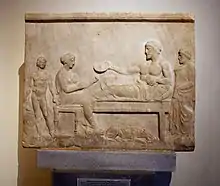Klinē
Klinai (Greek for couches; singular klinē,[1] and known in Latin as lectus triclinaris)[2] were a type of ancient furniture used by the ancient Greeks in their symposia and by the ancient Romans in their somewhat different convivia.[3]

In the later part of the Hellenistic period an arrangement of three klinai positioned in a 'U' shape developed, which together formed the triclinium.[4] Each kline of a triclinium offered room for three diners, and the seating arrangement of the reclining dinner guests was given a strict significance.[4]
A two-klinai arrangement created a biclinium, with the two couches either at a right angle[5] or facing each other.[6] Biclinium (plural biclinia) may also mean a dining couch for two persons in ancient Rome. [7]
References
- Stansbury-O'Donnell, Mark (2015). A History of Greek Art. John Wiley & Sons. pp. 119–. ISBN 978-1-4443-5014-2. Retrieved 10 June 2020.
- Venit, Marjorie Susan (2016). Visualizing the Afterlife in the Tombs of Graeco-Roman Egypt. Cambridge University Press. p. 51. ISBN 9781107048089. Retrieved 10 June 2020.
- Murray, Oswyn (2015). convivium. doi:10.1093/acrefore/9780199381135.013.1806. ISBN 978-0-19-938113-5. Retrieved 10 June 2020.
{{cite book}}:|work=ignored (help) - Tomlinson, Richard Allan (2015). "dining-rooms". Oxford Research Encyclopedia of Classics. doi:10.1093/acrefore/9780199381135.013.2176. ISBN 978-0-19-938113-5. Retrieved 10 June 2020.
{{cite book}}:|work=ignored (help) - Mols, Stephan T.A.M. (2020). Wooden Furniture in Herculaneum: Form, Technique and Function. BRILL. p. 124. ISBN 9789004425842. Retrieved 10 June 2020.
- Salza Prina Ricotti, Eugenia (1987). The importance of water in Roman garden triclinia. p. 17. ISBN 9780884021629. Retrieved 10 June 2020.
{{cite book}}:|work=ignored (help) - "biclinium". Merriam-Webster Dictionary. Merriam-Webster, Inc. Retrieved 10 June 2020.